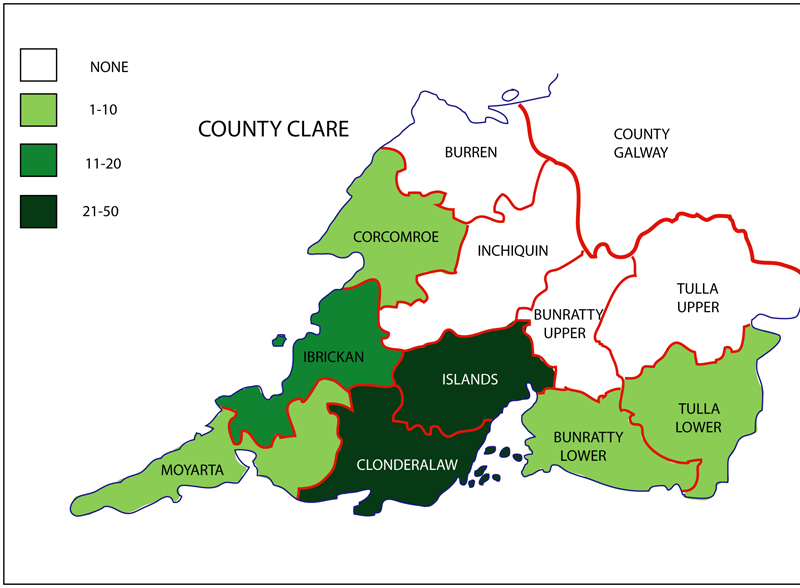
 Tuadhmhumhain meaning in English “North Munster ” the ancestral territory of the Dál Cais tribe later known as the Uí Briain, the descendants of Brian Borumha or Brian Boru. This Gaelic Kingdon repelled the Norman invaders and welcomed Gaelic refugees from conquered lands including the Ua Cléirigh clan from Kilmacduagh.
Tuadhmhumhain meaning in English “North Munster ” the ancestral territory of the Dál Cais tribe later known as the Uí Briain, the descendants of Brian Borumha or Brian Boru. This Gaelic Kingdon repelled the Norman invaders and welcomed Gaelic refugees from conquered lands including the Ua Cléirigh clan from Kilmacduagh.
Thomond remained as an independent kingdom until in 1543 Mourrough Uí Briain surrendered his Irish royalty to King Henry VIII of England and the same year he was raised to the Peerage of Ireland as Earl of Thomond,
However many centuries later some of the Uí Cléirighs from Cil Barrainn (Kilbarron )in Tír Connaill came to work as Ollamhs and poets to the O’Briens Earls of Thomond. In a documented incident, one Muiris Ballach was executed by Conor O’Brien, Third Earl of Thomond in 1572 along with two other poets who had offended the lord with their words!
The Annals of the Four Masters recorded that in 1595 Muiris Ballach’s brother “Maccon Uí Cléirigh son of Cúcoigcríche, son of Diarmaid, son of Tadhg Cam Uí Cléirigh, Ollamh to Uí Domhnaill in history, an erudite and ingenious man, professed in history and poetry; a fluent orator, with the gift of elocution, address, and eloquence; a pious, devout, religious and charitable man died at Lettermoylan in Thomond”
Lettermoylan was situated in the Parish of Inagh in the barony of Inchiquin and Cúcoigcríche was visiting the learned family of Mac Bhruaideadha. That he was only visiting and not living there at that time is verified in an essay called “Lettermoylan of Clann Bhruaideadha” by Luke McInearney in the North Munster Antiquarian Journal vol. 52, 2012
“This confusion arose from the misleading identification in John O’Donovan’s edited version of the Annals of the Four Masters (1856).3 There it states Lettermoylan lay in Dysert within a subdivision of ‘Glangee’. This identification was appended as a note by O’Donovan accompanying the annalistic recording of the death in 1595 of Maccon Ó Cléirigh ollamh to Ó Domhnall in history, who died while visiting ‘Leitir-Maelain in Thomond’(Leitir Maolain i tuadhmumhain).”
However in the Civil Survey of 1659, no O’Clerys or Clearys listed as the prominent Irish surnames in any of the Co Clare baronies.
In the Flax Growers listings for Co Clare which is dated 1796 there are three Clearys listed for the parish of Killimor which is likely a misspelling of the parish of Killimer in the barony of Clonderalaw see : https://www.failteromhat.com/post1796.php This Flax bounty was an incentive given by the Irish Parliament for farmers to grow flax as it was one of the exports that Ireland was allowed to export to England and was an important earner for farmers. The three listed are John, Thomas and Timothy Cleary all living in Killimor (Killimer).
By the time Griffiths Survey was carried out in the county in 1858, the main centre for the surname was still in the Barony of Clonderalaw with fifty ratepayers listed.

![]()
